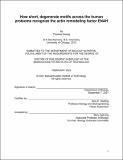How short, degenerate motifs across the human proteome recognize the actin remodeling factor ENAH
Author(s)
Hwang, Theresa
DownloadThesis PDF (6.161Mb)
Advisor
Keating, Amy E.
Terms of use
Metadata
Show full item recordAbstract
Protein-protein interactions form the backbone of the myriad signaling pathways that cells use to respond to their environments. A central class of protein-protein interactions in eukaryotic interactomes are those that occur between short linear motifs (SLiMs) and structured domains. SLiMs are stretches of 3-10 residues found in intrinsically disordered regions of proteins. Given their degeneracy, short length, and weak affinities, it is not immediately clear how such low complexity interaction elements are able to discriminate amongst the many homologous SLiM-binding domains within the cell.
Prior work on SLiMs has focused primarily on the “core motif”, or the minimal set of amino acids necessary to bind to a given domain. However, SLiMs are embedded in the context of larger proteins. In this thesis, I highlight the critical role of the sequence context surrounding SLiMs in modulating binding to the SLiM-binding Ena/VASP EVH1 domain family. I identified three mechanisms by which adjacent and distal sequence elements surrounding native EVH1-binding SLiMs enhance binding affinity and specificity to ENAH, an Ena/VASP paralog. I also determined the strategies employed EVH1 domains to recognize these extended SLiMs. Notably, the ENAH EVH1 domain leverages a network of dispersed residues to adopt a conformation that Ena/VASP paralogs VASP and EVL cannot access. An extended SLiM in cilia-associated protein PCARE exploits this conformation to bind ENAH with high specificity and affinity. I used this information to design selective and tight peptide inhibitors that could disrupt ENAHmediated interactions in mammalian cells.
Collectively, my work highlights the importance of studying SLiMs in their native context, motivating the application of my work to other SLiM-binding domain families.
Date issued
2022-02Department
Massachusetts Institute of Technology. Department of BiologyPublisher
Massachusetts Institute of Technology